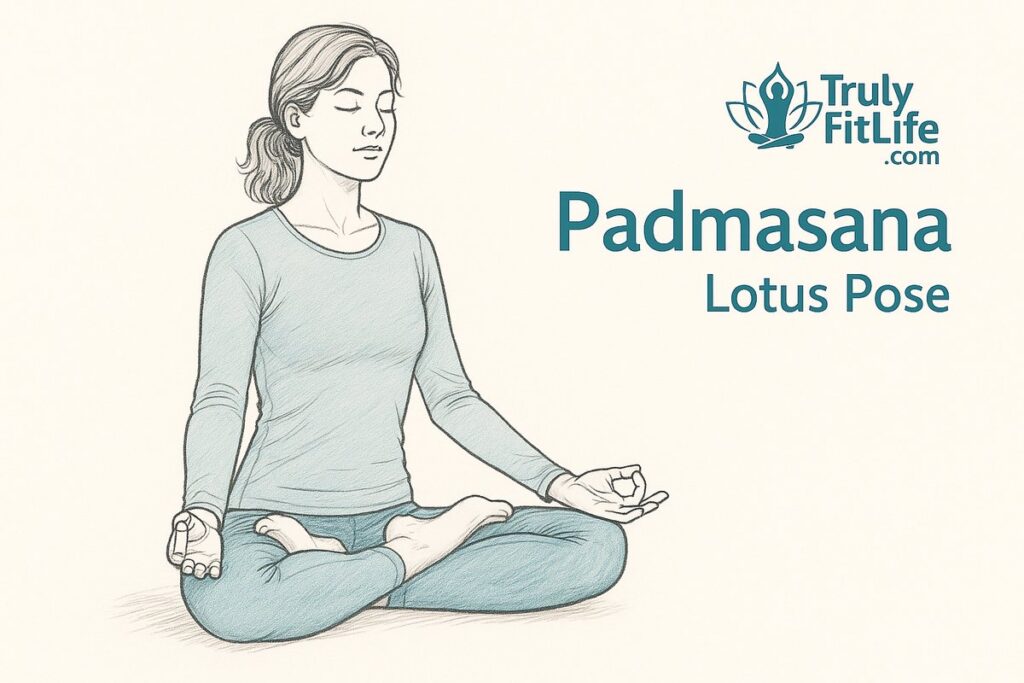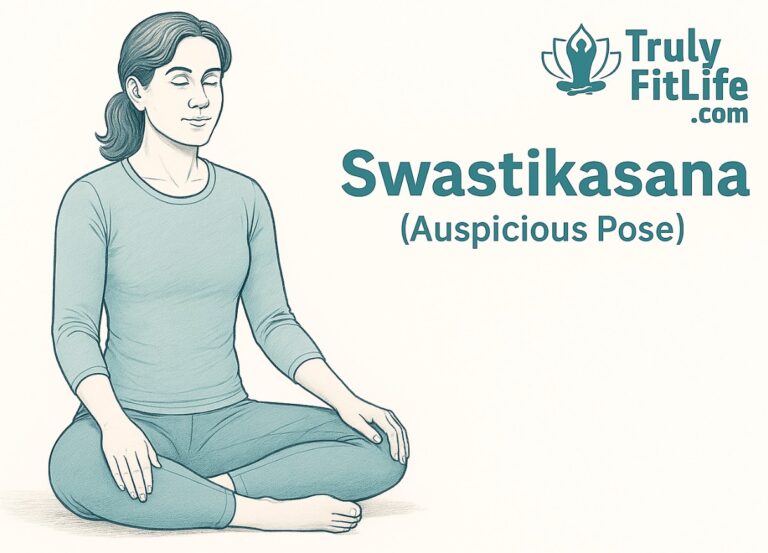
Introduction: What is Padmasana (Lotus Pose)?
Padmasana, also known as the Lotus Pose, is one of the most iconic yoga postures practiced for centuries in India. In Sanskrit, Padma means “lotus,” symbolizing purity and enlightenment, and asana means “pose.”
It is a classic seated yoga posture where the legs are crossed, and each foot is placed on the opposite thigh, resembling the petals of a lotus flower. Traditionally, Padmasana is considered the ideal position for meditation and pranayama practices because it brings stability, calmness, and alignment of body and mind.
This posture is often depicted in statues of ancient yogis, sages, and even deities like Lord Shiva and Buddha.
Sanskrit Name and Pronunciation
- Sanskrit: पद्मासन (Padmāsana)
- Pronunciation: Pud-mah-suh-nah
- English Name: Lotus Pose
Step-by-Step Instructions to Practice Padmasana
1. Preparation
- Sit on a yoga mat in Dandasana (Staff Pose) with legs extended forward.
- Keep the spine straight and shoulders relaxed.
- Take a few deep breaths to center yourself.
2. Leg Placement
- Bend your right knee and place your right foot on your left thigh.
- The sole should face upward, and the heel should be close to the abdomen.
- Then bend your left knee and place the left foot on the right thigh in the same manner.
3. Hand Position
- Rest your hands on the knees in Chin Mudra (thumb and index finger touching) or Jnana Mudra.
- Keep palms facing upward.
4. Alignment
- Keep the head, neck, and spine upright.
- Close your eyes and relax the entire body.
- Focus on your breath, allowing your mind to settle into meditation.
5. Duration
- Beginners can hold for 1–2 minutes, gradually increasing to 15–30 minutes with practice.
Health Benefits of Padmasana (Lotus Pose)
Practicing Padmasana regularly offers a wide range of physical, mental, and spiritual benefits:
🧘 Physical Benefits
- Improves Flexibility – Stretches hips, ankles, and knees.
- Strengthens Joints – Enhances hip joint mobility.
- Corrects Posture – Encourages natural alignment of the spine.
- Boosts Circulation – Increases blood flow in the lower body.
- Supports Digestion – Gentle pressure on abdominal organs improves metabolism.
🧠 Mental Benefits
- Calms the Mind – Encourages focus and mindfulness.
- Reduces Stress – Promotes relaxation by activating the parasympathetic nervous system.
- Enhances Concentration – Ideal for meditation and breathing practices.
🔮 Spiritual Benefits
- Balances Chakras – Especially activates the Muladhara (Root Chakra) and Sahasrara (Crown Chakra).
- Improves Energy Flow – Creates stability and enhances prana (life force).
- Aids Meditation – Provides steadiness for deeper spiritual practice.
Contraindications and Safety Precautions
- Avoid Padmasana if you have knee injuries, ankle problems, or hip stiffness.
- Pregnant women should consult a yoga teacher before attempting this pose.
- Never force your legs into Padmasana; progress gradually through preparatory poses.
- If discomfort arises, come out of the posture slowly.
Preparatory Poses for Padmasana
Before attempting Padmasana, practice these poses to improve hip and knee flexibility:
- Ardha Padmasana (Half Lotus Pose)
- Baddha Konasana (Butterfly Pose)
- Virasana (Hero Pose)
- Upavistha Konasana (Wide-Angle Seated Forward Bend)
Variations and Modifications
- Ardha Padmasana (Half Lotus Pose): Place one foot on the opposite thigh and the other leg beneath. Ideal for beginners.
- Easy Pose (Sukhasana): Cross-legged sitting posture for those unable to perform full lotus.
- Support with Cushion: Place a folded blanket under the hips for additional comfort.
Drishti (Gaze) and Breath Awareness
- Drishti: Focus on the space between the eyebrows (Bhrumadhya Drishti) or keep eyes gently closed.
- Breath: Maintain slow, deep breathing or practice pranayama such as Anulom Vilom or Kapalabhati while seated in Padmasana.
Common Mistakes to Avoid
- Forcing the legs into the posture without flexibility.
- Hunching the back or slouching.
- Practicing on hard surfaces without support.
- Ignoring discomfort in knees or hips.
Padmasana in Meditation and Pranayama
Padmasana is often used for:
- Meditation practices like mindfulness and mantra chanting.
- Breathing exercises such as Bhastrika, Kapalabhati, and Nadi Shodhana.
- Mudras and Bandhas for advanced yoga practitioners.
Its stability makes it one of the most recommended poses for long hours of meditation.
Conclusion
Padmasana, the Lotus Pose, is more than just a yoga posture. It is a symbol of spiritual awakening, physical balance, and mental calmness. While beginners may find it challenging at first, consistent practice with proper preparatory poses can help you achieve it safely.
If practiced mindfully, Padmasana becomes the perfect seat for meditation, pranayama, and inner peace.

